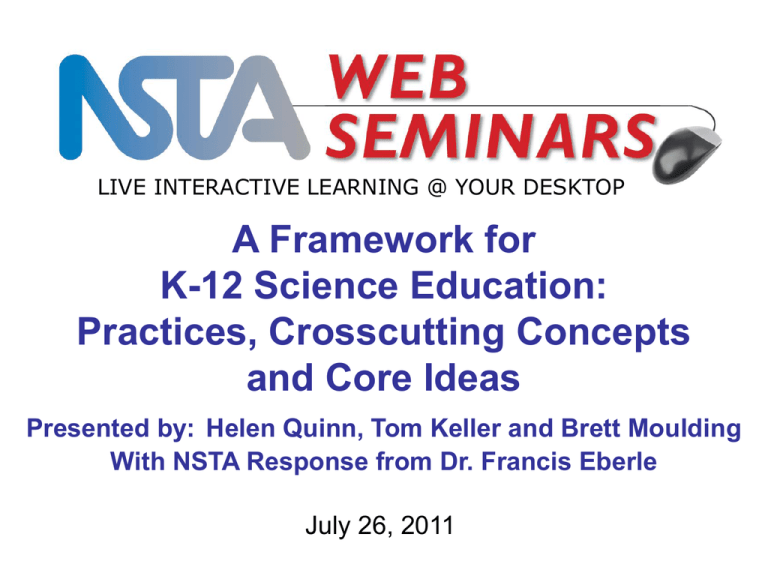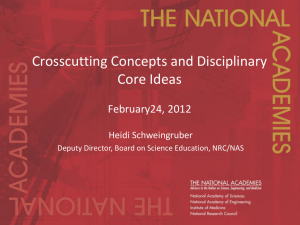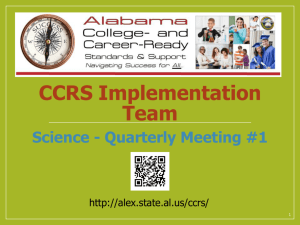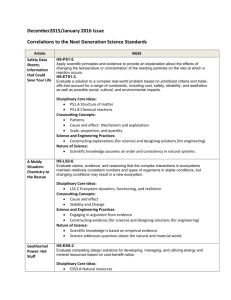A Framework for K-12 Science Education: Practices, Crosscutting Concepts and Core Ideas
advertisement

LIVE INTERACTIVE LEARNING @ YOUR DESKTOP A Framework for K-12 Science Education: Practices, Crosscutting Concepts and Core Ideas Presented by: Helen Quinn, Tom Keller and Brett Moulding With NSTA Response from Dr. Francis Eberle July 26, 2011 Assessments Curricula Framework Standards Instruction Teacher development Why now? • Improved knowledge about learning and teaching science • Opportunities to improve current teaching practice • Advances in scientific knowledge Who are we? National Research Council Board on Science Education Committee Members Helen Quinn, Chair Stanford University (Physics) Wyatt Anderson, University of Georgia (Biology) Tanya Atwater, UC Santa Barbara (Earth Science) Philip Bell, University of Washington (Learning Sciences) Thomas Corcoran, Center for Policy Research in Education, Columbia Teachers College Rodolfo Dirzo, Stanford University (Biology) Phillip Griffiths, Institute for Advanced Study, Princeton (Mathematics) Dudley Herschbach, Harvard University (Chemistry) Brett Moulding, Educator, Utah Linda Katehi, UC Davis (Engineering) Deborah Smith, Pennsylvania State University (Elementary Education) John Mather, NASA (Astrophysics) Jonathan Osborne, Stanford University (Science Education) James Pellegrino, University of Illinois at Chicago (Learning Sciences) Stephen L. Pruitt, GA Department of Education (until June, 2010) Brian Reiser, Northwestern University (Learning Sciences) Rebecca Richards-Kortum, Rice University (Engineering) Walter Secada, University of Miami (Mathematics Education) Design Teams Earth and Space Science Michael Wysession (Lead), Department of Earth and Planetary Sciences, Washington University in Saint Louis Scott Linneman, Geology Department, Western Washington University Eric Pyle, Department of Geology & Environmental Science, James Madison University Dennis Schatz, Pacific Science Center Don Duggan-Haas, Paleontological Research Institution and its Museum of the Earth Life Science Rodger Bybee (Lead), BSCS Bruce Fuchs, National Institutes of Health Kathy Comfort, WestEd Danine Ezell, San Diego County Office of Education Physical Science Joseph Krajcik (Lead), School of Education, University of Michigan Shawn Stevens, School of Education, University of Michigan Sophia Gershman, Watchung Hills Regional High School Arthur Eisenkraft, Graduate College of Education, University of Massachusetts Angelica Stacy, Department of Chemistry, University of California, Berkeley Engineering, Technology and Applications of Science Cary Sneider (Lead), Center for Education, Portland State University Rodney L. Custer, Department of Technology, Illinois State University Jacob Foster, Mass. Department of Elementary and Secondary Education Yvonne Spicer, Nat’l Center for Technological Literacy, Museum of Science, Boston Maurice Frazier, Chesapeake Public School System Let’s pause for questions from the audience Vision: Science for All Students • Science, engineering and technology are cultural achievements and a shared good of humankind • Science, engineering and technology permeate modern life • Understanding of science and engineering is critical to participation in public policy and good decisionmaking • National need Vision: Coherent learning • Coherent investigation of core ideas across multiple years of school • More seamless blending of practices with core ideas and crosscutting concepts Structure of the Report • Part I: A Vision for K-12 Science Education • Part II: Dimensions of the Framework • Part III: Realizing the Vision Three Dimensions • Scientific and engineering practices • Crosscutting concepts • Disciplinary core ideas Scientific and Engineering Practices 1. Asking questions and defining problems 2. Developing and using models 3. Planning and carrying out investigations 4. Analyzing and interpreting data 5. Using mathematics and information and computer technology 6. Developing explanations and designing solutions 7. Engaging in argument 8. Obtaining, evaluating, and communicating information Do your students use modeling for understanding? A. Habitually, in science B. When prompted, often C. When prompted, sometimes D. Rarely E. Never Do your students distinguish a claim and supporting evidence? A. Readily B. When prompted, often C. When prompted, sometimes D. Rarely E. Never Crosscutting Concepts 1. Patterns 2. Cause and effect 3. Scale, proportion and quantity 4. Systems and system models 5. Energy and matter 6. Structure and function 7. Stability and change Do your students use the language of systems? A. Readily B. When prompted, often C. When prompted, sometimes D. Rarely E. Never A core idea for K-12 science instruction is a scientific idea that: • Has broad importance across multiple science or engineering disciplines or is a key organizing concept of a single discipline • Provides a key tool for understanding or investigating more complex ideas and solving problems • Relates to the interests and life experiences of students or can be connected to societal or personal concerns that require scientific or technical knowledge • Is teachable and learnable over multiple grades at increasing levels of depth and sophistication Disciplinary Core Ideas: Physical Sciences • PS1 Matter and its interactions • PS2 Motion and stability: Forces and interactions • PS3 Energy • PS4 Waves and their applications in technologies for information transfer Disciplinary Core Ideas: Life Sciences • LS1 From molecules to organisms: Structures and processes • LS2 Ecosystems: Interactions, energy, and dynamics • LS3 Heredity: Inheritance and variation of traits • LS4 Biological evolution: Unity and diversity Disciplinary Core Ideas: Earth and Space Sciences • ESS1 Earth’s place in the universe • ESS2 Earth’s systems • ESS3 Earth and human activity Disciplinary Core Ideas: Engineering, Technology and Applications of Science • ETS1 Engineering design • ETS2 Links among engineering, technology, science and society Let’s pause for questions from the audience Integrating the Dimensions Chapter 9 • To facilitate students’ learning the dimensions must be woven together in standards, assessments, curriculum and instruction. • Students should explore a core idea by engaging in the practices and making connections to crosscutting concepts. Key Components in the System that Need to be Aligned for Implementation Chapter 10 • Standards • Curriculum and instructional materials • Assessment • Pre-service preparation of teachers • Professional development for in-service teachers Diversity and Equity Chapter 11 • Equalizing opportunities to learn • Inclusive science instruction • Making diversity visible • Value multiple modes of expression Guidance for Standards Developers Chapter 12 • Set rigorous learning goals for all students • Emphasize all 3 dimensions • Include performance expectations • Be organized as progressions that support learning over multiple grades • Attend to issues of diversity and equity Key Areas of Research Chapter 13 • Learning progressions • Scientific and engineering practices • Curricular and instructional materials • Assessment • Supporting teachers’ learning • Evaluation of the impact of standards Let’s pause for questions from the audience Major changes from July draft • Re-organized chapters • Added chapters on implementation, diversity and equity, and guidance for standards developers • Expanded discussion of integrating the three dimensions • Replaced “prototype learning progressions” with “gradeband endpoints” Next Steps • Outreach and dissemination of the framework by the NRC • State-led development of Next Generation Science Standards, coordinated by Achieve • Progress on critical steps toward implementation Free PDF version of A Framework for K-12 Science Education is available at: http://www.nap.edu/catalog.php?record_id=13165 Response from NSTA Thank you to the sponsor of tonight's Web Seminar: This web seminar contains information about programs, products, and services offered by third parties, as well as links to third-party websites. The presence of a listing or such information does not constitute an endorsement by NSTA of a particular company or organization, or its programs, products, or services. http://learningcenter.nsta.org http://www.elluminate.com National Science Teachers Association Dr. Francis Q. Eberle, Executive Director Zipporah Miller, Associate Executive Director Conferences and Programs Al Byers, Assistant Executive Director e-Learning NSTA Web Seminars Paul Tingler, Director Jeff Layman, Technical Coordinator LIVE INTERACTIVE LEARNING @ YOUR DESKTOP



